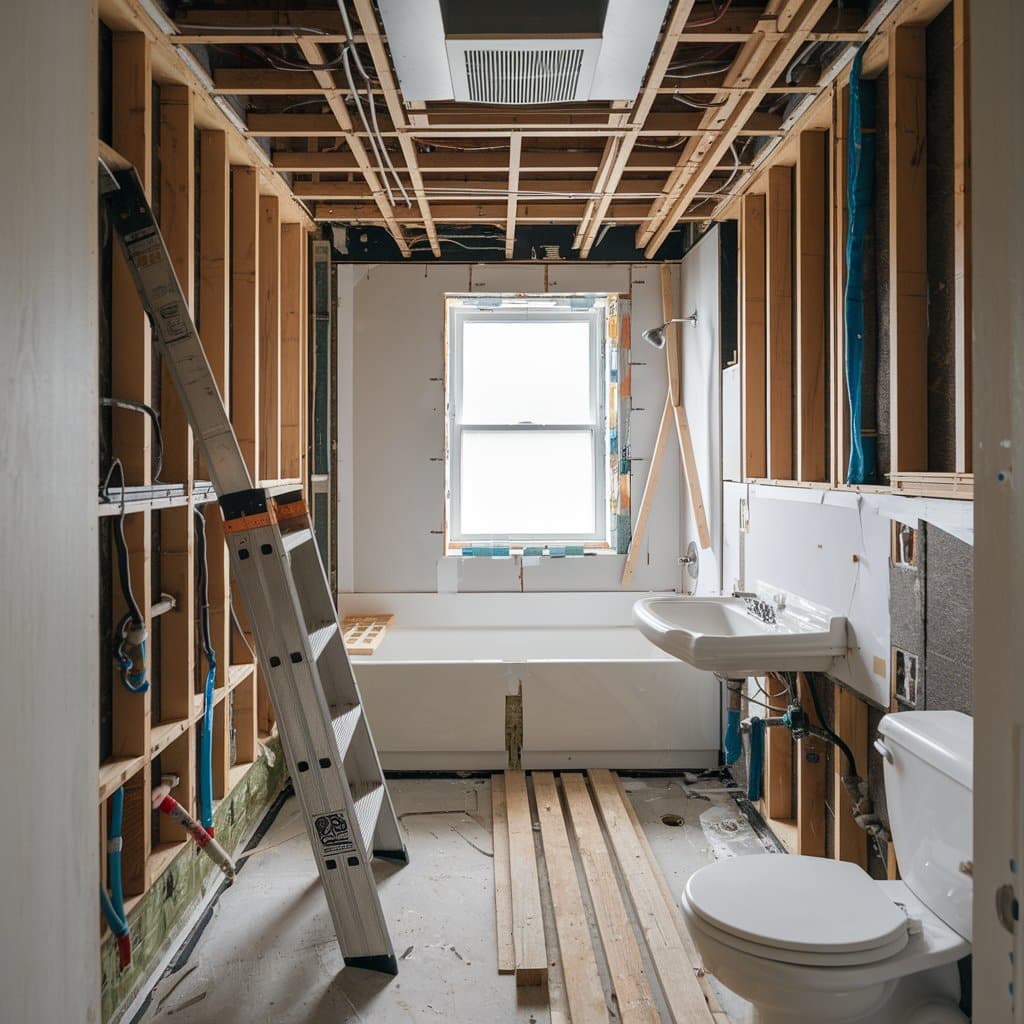Renovation Guide
Renovating a house in New Zealand involves careful planning and adherence to regulations.
Learn the exact steps to avoid the common costly mistakes:
Not obtaining necessary building consents
Underestimating
the cost
Poor
planning
Hiring unreliable contractors
We are here to help you turn your renovation dreams into reality
offering comprehensive renovation expertise for your entire project
Get Started on your Renovation
DESIGN
- Defining the scope of the project and
- Designing the changes
The scope of the project
Begin by creating a strategic wishlist that separates essential must-haves from aspirational nice-to-haves. Look beyond today and envision your future lifestyle needs—whether that’s accommodating a growing family, creating space for elderly parents, or designing a home that evolves with you through life’s changes.
Designing the changes
Visualize Your Transformation with AI-Powered Design
Experience your renovation before it begins through revolutionary AI-powered design tools that bring your vision to life. Navigate virtual walkthroughs of your reimagined space, experiment with design elements in real-time, and confidently evaluate how different configurations will function in your daily life. This immersive approach eliminates guesswork and ensures your renovation delivers exactly the atmosphere and functionality you desire.
Complex Renovations
Depending on the complexity of the renovation, you’ll need drawings that illustrate the proposed changes. These can range from simple sketches for minor cosmetic updates to detailed architectural plans for structural alterations or additions. These plans should show:
- Existing layout and proposed new layout.
- Dimensions and measurements.
- Location of walls (indicating if they are load-bearing), doors, windows, and openings.
- Elevations and sections, if necessary, to show vertical aspects of the design.
Popular AI Tools
The AR Ruler App transforms your smartphone into a precision measuring tool using augmented reality. Measure in multiple units, from small objects on-screen to 3D distances and corners between objects in real space.
SETTING A BUDGET
Underestimating the cost is one of the common mistakes people make while renovationg their homes.
It’s crucial to have a realistic budget and a contingency fund for unexpected issues.
While an average cost per square meter for building exists, renovation costs are highly specific to the project – the size of your house, the complexity of the project and the materials you choose.
Getting an estimate
To get an accurate idea of the cost, it’s recommended to get quotes from builders or renovation companies. Some websites also offer cost calculators as a starting point, but these should be used as a guide only.
Renovation Cost Guide
Additional contingency funds required: 10-20% above the planned spending.
DEVELOPING A TIMELINE
Planning how long your renovation will take is crucial. Developing a timeline for a house renovation involves several key steps and considerations.
Factors that can influence the timeline:
- Scope and Complexity: Larger, more complex renovations take longer.
- DIY vs. Professionals: Doing work yourself can sometimes take longer if you’re less experienced, but you have more control over scheduling. Relying on contractors means working with their availability.
- Material Availability: Delays in receiving materials can hold up the project.
- Unexpected Issues: Discovering issues like mold, structural problems, or outdated wiring during demolition can add significant time.
- Permitting and Inspections: The speed of your local building department can impact the timeline.
- Budget: Budget constraints might force you to phase the project, extending the overall timeline.
Important Considerations
Where will you live during construction?
Your living arrangements really matter, especially for big projects like whole-house renovations. You’ll need to decide whether to:
- Stay in your home during work (possible for smaller projects)
- Move in with family or friends temporarily
- Rent another place while work is happening
- Schedule a vacation during the messiest parts
Our team can help you figure out the safest and most practical approach based on your specific situation.
Don't forget about money
Make sure your financing is lined up before construction starts. You might need to:
- Set up a renovation loan
- Arrange for payment schedules with contractors
- Keep some extra funds available for unexpected costs
OBTAINING PERMITS
The types of renovation work that commonly require a building consent:
- Structural Alterations: Removing or altering load-bearing walls, adding new walls that are load-bearing, changing the roof structure, or making other changes that affect the building’s structural stability.
- Plumbing and Drainage: Installing new plumbing, relocating existing plumbing, or making significant changes to drainage systems.
- Electrical Work: While minor electrical repairs might not need consent, significant alterations to the wiring, adding new circuits, or installing new electrical systems usually require consent and must be done by a registered electrician.
- Changes to the Building Envelope: Alterations to the exterior walls, windows, doors, or roof that affect the weathertightness or structural performance of the building. This includes re-cladding or significant window/door replacements.
- Adding or Removing Rooms: Creating new rooms or significantly altering the layout by removing internal walls, especially if they are load-bearing.
- Building Additions: Extending the footprint of your house.
- Decking and Balconies: Building decks or balconies above a certain height or size often requires consent.
- Retaining Walls: Building retaining walls over a certain height (usually 1.5 meters) or those supporting a surcharge (like a driveway or building) require consent.
- Fences: Fences over a certain height (usually 2.5 meters) or those near a boundary with a swimming pool require consent.
- Swimming Pools and Fences: Installing a swimming pool and the associated safety fencing requires consent.
- Relocating a Building: Moving an existing building to a new site.
How long does it take to process the application
building consent applications must generally be processed within 20 working days of being accepted by the council.
However, the actual time taken within this 20-day period can vary. It’s always best to submit a complete and accurate application to help ensure the process is as smooth and timely as possible.
AVOID guesswork - use our expertise!
Important Considerations
Exemptions
The Building Act does provide exemptions for certain types of minor building work. These exemptions are regularly updated, so it’s essential to check the latest regulations. Websites like building.govt.nz have detailed information on what work is exempt.
Local Council Variations
While the Building Code is national, local councils may have specific bylaws or requirements that could affect whether consent is needed for certain projects in their area.
Resource Consent
Remember that a building consent is different from a resource consent. Resource consent may be required if your project has potential effects on the environment or neighbours, regardless of whether a building consent is needed.
Consequences of not getting consent

SOURCING MATERIALS
Before you start shopping, finalize your renovation plans and create a detailed list of materials required for each stage. Work closely with your builder or project manager (if you have one) to understand the specifications and quantities needed. Knowing the project timeline will also help you order materials to arrive when they are needed, avoiding storage issues or costly delays.
Explore your suppliers options
New Zealand offers a range of places to source renovation materials:
- Large Retail Chains (e.g., Bunnings, Mitre 10): These are convenient one-stop shops for a wide variety of building supplies, hardware, tools, and some finishing materials. They often have good stock levels and frequent sales. Great for standard items and DIY supplies.
- Specialty Suppliers: For specific items like tiles, flooring, plumbing fixtures, lighting, or kitchen/bathroom fittings, visit dedicated showrooms and suppliers. They often offer a wider range of styles, higher quality options, and expert advice. Examples include tile shops, plumbing merchants, lighting stores, etc.
- Timber & Building Supply Yards: For structural timber, plasterboard, insulation, roofing, and other core building materials, go directly to timber and building supply yards. They cater more to trade but are open to the public and can offer competitive pricing on bulk items.
- Online Retailers: A growing option for everything from tapware and lighting to furniture and decor. Can offer competitive prices and unique items, but check shipping costs and return policies carefully.
- Salvage Yards & Second-Hand Stores: For character homes or budget-friendly options, explore architectural salvage yards and second-hand building material stores. You can find unique doors, windows, timber, bricks, and fixtures with history.
- Direct from Manufacturers/Wholesalers: Sometimes, for larger quantities or specific products (like certain types of cladding or roofing), you might be able to buy directly or through a recommended distributor.
We'll Help You Save on Materials
We’ve built strong relationships with premium suppliers over the years. By purchasing materials through us, you’ll often get better prices than buying directly. Let us provide you with a competitive quote for all the materials your project requires.
Important Considerations
Understand NZ Building Codes and Standards
Get Multiple Quotes
Check Availability and Lead Times
Supply chain issues can affect renovation timelines. Always confirm the availability of materials and get realistic lead times, especially for imported goods, custom orders (like joinery), or popular items that might be on backorder. Order long lead-time items as early as possible.
Plan for Delivery and Storage
Think about how materials will get from the supplier to your site and where they will be stored safely and protected from the weather until they are needed. Factor delivery costs into your budget.

BUILDING
Once the planning is complete, permits are (if needed) in hand, and materials are being sourced, you enter the dynamic and often intense building phase of your renovation.
Effective management is key to staying on track, on budget, and achieving the desired quality.
Project manager's key responsibilities:
- Scheduling: Coordinating when each trade needs to be on site to ensure a smooth flow of work and avoid conflicts.
- Communication: Being the point of contact, answering questions, and relaying information between different trades.
- Supervision: Checking that trades are turning up as scheduled and working efficiently.
- Comparing actual progress against your planned timeline.
- Identifying potential delays early and finding solutions.
- Adjusting the schedule as needed due to unforeseen issues or changes.
- Regularly inspecting the work being done to ensure it meets the agreed-upon standards and specifications.
- Addressing any issues or poor workmanship promptly. Don’t wait until the end!
- Ensuring compliance with building codes.
- Confirming materials are ordered and delivered to site before the relevant trade needs them.
- Checking deliveries against orders for accuracy and damage.
- Ensuring materials are stored correctly and safely on site.
- Keeping track of invoices and payments to trades and suppliers.
- Monitoring costs against your budget and managing any variations.
- Being prepared to make quick decisions to resolve issues that arise on site.
- Mediating any disagreements between different trades.
- Keeping your household informed about progress and disruption.
- Communicating with neighbours if the work impacts them.
Let Us Handle the Heavy Lifting
The building phase is demanding, requiring constant attention to detail, problem-solving skills, and effective communication. Staying organized and proactive is your best strategy for navigating this complex stage successfully.
Why choose Max Style as your building contractor
All In One
From Concept to Completion.
Residential, Commercial and AUTEX Acoustics
Superior Quality
Skilled and reliable team with craftsmen and managers bringing 30+ years experience
Hassle Free
Keeping disruptions to a minimum with an approachable team you’ll find easy to work with
On Time and Budget
Minimising surprises through meticulous planning and transparent communication
Up to Standards
Strong H&S systems in place. Master Builders warranty

COMPLIANCE
Getting a Code of Compliance Certificate (CCC) for a renovation in New Zealand is a formal process handled by your local council. It’s essentially the council’s confirmation that the building work carried out under a Building Consent complies with the New Zealand Building Code.
What Needs to Be Done to Get a CCC?
Getting a CCC isn’t just about applying at the end; it’s a process that runs throughout the entire building phase:
- Obtain a Building Consent FIRST: You must apply for and receive a Building Consent from your local council before you start any work that requires one (most structural changes, plumbing, electrical, significant weather-tightness work, etc.). The consent outlines the approved plans and the inspections required.
- Carry Out Work According to Consent: The renovation work must be built strictly according to the approved plans and specifications in your Building Consent. Any deviations need to be formally applied for as an “Amendment to Building Consent.”
- Arrange and Pass Mandatory Inspections: This is a critical part. Your Building Consent will list mandatory inspections required at various stages of the build (e.g., foundation, framing, plumbing/electrical/drainage rough-in, insulation/pre-line, final inspection). You or your builder must book these inspections with the council, and a council inspector must check and sign off the work at each stage before you can proceed to the next.
- Gather Required Documentation: As the build progresses, you need to collect specific documents from your tradespeople and professionals. This is often where delays occur if not managed proactively. Key documents include:
- Producer Statements (PS3/PS4): If engineers or other chartered professional engineers were involved in the design or monitoring of the build, they will provide these statements confirming aspects of compliance.
- Certificates of Work: If your project involves “Restricted Building Work” (RBW), Licensed Building Practitioners (LBPs) must provide Certificates of Work for the parts they carried out or supervised.
- Electrical Safety Certificate (ESC) and Certificate of Compliance (CoC): From your registered electrician.
- Plumbing and Drainage Certificate of Compliance: From your registered plumber/drainlayer.
- Gasfitting Certificate of Compliance: From your registered gasfitter (if applicable).
- Manufacturer’s Guarantees/Warranties: For key products like windows, cladding, roofing, and sometimes insulation.
- Installation Records: Evidence that certain products were installed according to manufacturer’s instructions and the Building Code.
- As-Built Drainage Plan: If new drainage was installed or altered.
- Documentation for any Variations: Records of any minor changes agreed upon during inspections.
- Complete the Building Work: All work covered by the Building Consent must be fully completed.
- Apply for the CCC: Once all work is finished and you have gathered all the required documentation and passed the final inspection, you submit the formal CCC application form to the council.
- Council Review: The council reviews your application, checks that all required inspections have been passed, and verifies that all necessary documentation has been submitted and is satisfactory.
We'll Navigate the Compliance Process For You
Paperwork Involved
- Completed CCC application form.
- Signed-off records of all mandatory inspections.
- Producer Statements (PS3, PS4) if applicable.
- Certificates of Work from LBPs.
- Electrical Safety Certificate and CoC.
- Plumbing and Drainage CoC.
- Gasfitting CoC (if applicable).
- Product warranties and installation details.
- As-built drainage plan (if applicable).
- Documentation for any approved amendments or minor variations.
How long does it take
While the 20-day clock is statutory, the time it takes for the council to initially review your submission and identify if anything is missing can vary depending on their workload.
Useful websites
The council has a statutory timeframe of 20 working days from the date they receive a complete CCC application to decide whether to issue or refuse it.
Provide specific information on local regulations, consent applications, and fees.
Offers articles on the legal requirements of building consents.












